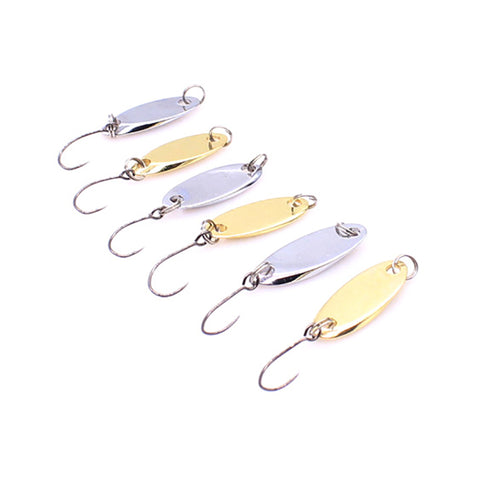There are five types of spoons exist and they are weedless, casting, trolling, surface, jigging spoons. Fishing spoons are either molded, forged or stamped from steel, copper, brass, wood, lead or plastic. Majority of the spoons in the market have one of their sides painted and the other side has a polished metallic surface that reflects the light from the sun. Some spoons have rippled or hammered finish that transmits light in two or more directions just as how the scales of baitfish scatter or transmit light.
The common types of spoons and their uses are listed and discussed as follows:
1. Weedless Spoons

Weedless spoons are used to provoke fish strike when fishing on the water that has aquatic weeds, thick covers, wood and logs. Most weedless spoons have a single hook welded on their bodies and there is an attached wire guard that prevents snags. You can try different retrieve techniques like “twitching and pausing,” allowing the spoon to settle into open holes. You can also try another method called “straight retrieve over and thru the cover.” This method involves tipping the hook with an extra attractor (trailer) like a pork rind or plastic grub. The size of weedless spoons ranges from ¼ oz. to 11/8 oz.
2. Traditional Casting Spoons
Traditional Spoons are also referred to as stamped metal casting spoons. They produce distinct forth and back wobbles when used underwater due to their oval-shaped cupped bodies. The size of traditional casting spoons ranges from 1/36 oz. for panfish to over 3 oz. for lake trout, pike and muskies. From ¼ to ¾ oz. are the most popular casting spoon sizes used for pike, walleyes and bass. All casting spoons have a single or treble hook attached to them with the help of a split ring that gives room for the hook to swing whenever the spoon wobbles.
This type of spoons is lighter and thinner than casting spoons. For example, the weight of a typical 3 inches trolling spoon is 1/8 oz., making it lighter than a casting spoon. Trolling spoons are also designed in such a way that depth can be controlled with a diving pane or downrigger. These spoons are a great choice for walleyes, trout and salmon due to their fluttering action.
4. Surface Spoons
Large predatory fish such as muskies, pike and bass normally hide in thick cover during summer. Surface spoons should be used in this situation. When a surface spoon is cast over water with highly matted vegetation, it floats with its hooks pointing upward to prevent the spoon from being snagged.
Most of the surface spoons on the market are made of a plastic material and extra attractors are normally attached to them. When you intend to use surface spoons to fish, you should point the tip of the fishing rod at the surface spoon. After catching a fish, you should feel the fish’s pressure before you set the hook. There is a tendency for the fish to miss the surface lure. In case a fish misses the surface lure, keep moving the lure until the fish gets caught again.
5. Jigging Spoons
Vertical jigging is one of the best ways to reach fish like bass or walleye in deep water. Jigging spoons are thick, heavy and flat, and they flash anytime they are jigged. This particular type of spoons is designed to go deep into water quickly.
An angler fishing with jigging spoons needs to use short jerks to increase his chances of striking a fish. It is worth mentioning that the fall of a jigging spoon results to many fish strikes. Always watch your fishing line while it falls in water. If the line twitches or stops, just set the hook immediately. A low stretch fishing line of 12-2 lbs. with a medium heavy fast action rod is the best for jigging spoons.







 Copyright © 2018 Basstrike. All Rights Reserved.
Copyright © 2018 Basstrike. All Rights Reserved.
Comments